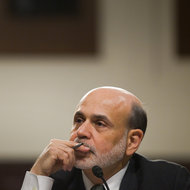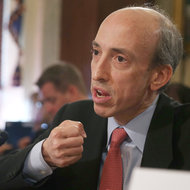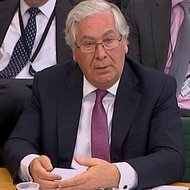 Stephen Crowley/The New York TimesBen S. Bernanke, the chairman of the Federal Reserve, testified before the Senate Banking Committee on Tuesday.
Stephen Crowley/The New York TimesBen S. Bernanke, the chairman of the Federal Reserve, testified before the Senate Banking Committee on Tuesday.
9:06 p.m. | Updated
Federal authorities cast further doubt on Tuesday about the integrity of a key interest rate that is the subject of a growing investigation into wrongdoing at big banks around the globe.
In Congressional testimony, the chairman of the Federal Reserve and the head of the Commodity Futures Trading Commission expressed concern that banks had manipulated interest rates for their own gain. They also indicated that flaws in the system — which were highlighted in a recent enforcement case against Barclays — persist.
“If these key benchmarks are not based on honest submissions, we all lose,”
Gary Gensler, head of the trading commission, which led the investigation into Barclays, said in testimony before the Senate Agriculture Committee.
In separate testimony before the Senate Banking Committee,
Ben S. Bernanke, the Federal Reserve chairman, said he lacked “full confidence” in the accuracy of the rate-setting process.
The Fed faces questions itself over whether it should have reined in the rate-manipulation scheme, which took place from at least 2005 to 2010.
Documents released last week show that the New York Fed was well aware of potential problems at Barclays in 2008. At a hearing in London on Tuesday, British authorities said the New York Fed never told them Barclays was breaking the law.
 Mark Wilson/Getty ImagesGary Gensler, the head of the Commodity Futures Trading Commission, testified before the Senate Agriculture Committee on Tuesday.
Mark Wilson/Getty ImagesGary Gensler, the head of the Commodity Futures Trading Commission, testified before the Senate Agriculture Committee on Tuesday.
 ReutersMervyn A. King, governor of the Bank of England, addressed a parliamentary committee on Tuesday.
ReutersMervyn A. King, governor of the Bank of England, addressed a parliamentary committee on Tuesday.
The scrutiny intensified on Tuesday as Representative Randy Neugebauer, chairman of the House subcommittee investigating the Libor scandal, announced plans to seek additional documents from the New York Fed about JPMorgan Chase, Citigroup and Bank of America, the three American banks involved in setting interest rates.
The concerns center on the London interbank offered rate, or Libor, an essential benchmark that affects the cost of borrowing for consumers and corporations. Trillions of dollars in mortgages and other financial products are tied to Libor, which is set daily based on reports from a panel of large banks.
Several government agencies, including authorities in the United States, Canada, Britain and Japan, are examining whether the banks made bogus reports.
Last month, Barclays agreed to settle with the Commodity Futures Trading Commission, the Justice Department and the Financial Services Authority of Britain for $450 million. The British bank was accused of reporting false rates that both bolstered its profits and projected an overly rosy image of its health during the financial crisis.
“The conduct occurred regularly and was pervasive,” Mr. Gensler said on Tuesday.
The actions also happened in plain view of regulators.
In 2008, Barclays informed the New York Fed that it was submitting artificially low rates. The concerns were passed on to
Timothy F. Geithner, then the chief executive of the regulatory body.
But the New York Fed did not tell other authorities in the United States or Europe about the specific problems at Barclays. Instead, it proposed changes to the rate-setting process. At the time, Mr. Geithner recommended in an e-mail that British officials “strengthen governance and establish a credible reporting procedure” and “eliminate incentive to misreport,” according to documents released last week.
“At no stage did he or anyone else at the New York Fed raise any concerns with the bank that they had seen any wrongdoing,” Mervyn A. King, governor of the Bank of England, told a British parliamentary committee on Tuesday, referring to Mr. Geithner.
Mr. King said his discussion with Mr. Geithner did not represent a warning sign about potential illegal activity.
“There was no suggestion of fraudulent behavior,” the British central bank official told Parliament. His colleague Paul Tucker, who also received the e-mail from Mr. Geithner, echoed his statements, saying in testimony that the recommendations “didn’t set off alarm bells.”
Rather, the British central bank passed along the proposed changes to the British Bankers’ Association, a trade group that oversees the rate.
In his testimony on Tuesday, Mr. King said that some of the New York Fed’s recommendations were included in a Libor review conducted by the trade group.
The British Bankers’ Association also sought feedback from the CME Group, the Chicago-based exchange, according to documents provided to The New York Times. In a July 2008 letter, the exchange argued that the plan “must have teeth” and “credibility.”
In late 2008, the British Bankers’ Association adopted changes to the Libor process. But neither the regulators nor the trade group put a stop to Barclays’ illegal activities, which continued through 2009.
On Tuesday, Mr. Bernanke issued a broad defense of the Fed’s actions in 2008 after it learned that banks were misrepresenting interest rates.
“Isn’t there a responsibility to alert the customers?” Senator
Jeff Merkley, Democrat of Oregon and a member of the Banking Committee, asked Mr. Bernanke. “If you had it to do over again, would you also be alerting the customers?”
Mr. Bernanke said it was hardly a secret that Libor was losing credibility. During the financial crisis, the media and the markets were swirling with speculation about problems with the rate-setting process. At the time, the Fed was primarily focused on saving Wall Street from collapse.
“The responsibility of the New York Fed was to make sure that the appropriate authorities had the information, which they did,” Mr. Bernanke said.
The Barclays case was the first to stem from the broader global investigation, which involves more than 10 other banks, including UBS and the Royal Bank of Scotland. While much scrutiny has focused on European banks, authorities are also investigating big Wall Street companies like Citigroup and JPMorgan.
Mr. Gensler on Tuesday said his agency “has and will continue vigorously to use our enforcement and regulatory authorities to protect the public, promote market integrity, and ensure that these benchmarks and other indices are free of manipulative conduct and false information.”
Banks, Mr. Gensler said, “must not attempt to influence” Libor. “It’s just wrong and against the law.”
But the problems may remain, say regulators. On Tuesday, Mr. Bernanke said the benchmark still lacked credibility.
“It’s clear beyond these disclosures that the Libor system is structurally flawed,” he told lawmakers.
Binyamin Appelbaum contibuted reporting.
Article source: http://dealbook.nytimes.com/2012/07/17/after-barclays-scandal-regulators-say-rates-remain-flawed/?partner=rss&emc=rss
Speak Your Mind
You must be logged in to post a comment.